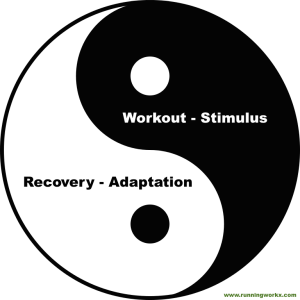The Importance of Recovery
Let’s talk recovery, the holidays are over and many of you are probably well into your training by now; preparing for your first big spring marathon of the year. I’ll bet a lot of the discussions taking place these days around Dunkin Donuts or Starbucks are probably centered on training and workouts. With so much emphasis on various workouts or what the current buzz in the running magazines are regarding the latest “must do” training regimens; we tend to forget that regardless of the workout details, our long-term physiological adaptations occur during the recovery period, not during the workout itself. So, shouldn’t recovery have a prominent place front and center in your training?
I like to think of it this way: If workouts were the yin, then recovery would be the yang. We can think of these two elements as inseparable, intertwined parts of a “balanced” whole. The combined whole creates a “positive training effect” that ultimately results in a physiological adaptation that contributes to an increase in our performance.
The work session merely provides the stress stimulus to the body’s systems. Depending on the stimulus, its intensity, duration, and frequency, it will serve as a catalyst for a physiological training effect known as super compensation. According to sports science theory, when the body is properly stressed it will adapt and overcompensate during the post-stimulus period to a higher level of performance than before. This is the premise of training whereby we repeatedly apply gradually increasing stress stimuli to the body to evoke greater and greater adaptations (progression), which if done correctly will hopefully translate into more strength, speed, stamina and endurance and maybe even a PR or age-group podium spot.
We need to be reminded that without proper recovery following a properly applied stimulus, there will be no positive adaptation. In fact, there may be a negative effect. It’s generally believed that it takes the body 8-14 days to adapt and benefit from a single specific workout, depending on the individual and their receptiveness to training stresses. The fact is, with chronic improper recovery you will be setting yourself up for a trend of diminished performance, or worse.
Definition of Recovery:
Defined as the rebuilding of damaged structures between workouts and the replenishment of energy stores within muscles (Hreljac, A. Impact and Overuse Injuries in Runners. Medicine & Science in Sports & Exercise, Vol 36, 2004).
What happens if you neglect your recovery?
Insufficient recovery leads to reduced physical performance, soreness/fatigue, increased risk of Injury/illness, overreaching; and if left unchecked, ultimately to that dreaded condition called “overtraining syndrome”.
As runners, we’ve all been there. We push our bodies seeking the win, the PR or breaking some new distance threshold. Then suddenly out of the blue, wham! Our performance seemingly drops off for no apparent reason. We may even get sick or suffer an injury. However, if we look at our daily running logs, more than likely the tell-tale signs and/or patterns are probably right there, but as is often the case, we oftentimes choose to ignore them and push on because that’s what “runners” are inclined to do.
Listen to Your Body
Sometimes we just need to stop for a moment and “listen” to our bodies. Even more difficult, is making the choice to take that extra rest day now and then, or back off on the volume or intensity for that day or week even when the schedule says differently. There are no hard and fast rules on recovery, but scheduling rest/recovery days is a good start and key to staying healthy and injury free. Just remember, no one knows you better than you. We are all individuals with unique physiological attributes and genetics. What works for one runner may not work for another. We all react differently to the stimulus of training, thus we individualize our workouts. By the same token, we also need to respect that same uniqueness by individualizing our recovery and how it is programmed into our training regimen. We’re basically looking for that optimum balance between work and recovery. The problem is it’s often a moving target, constantly in a state of change as our bodies adapt and fitness levels progress. What worked last year may not be the case this year or next.
For Older Runners Recovery is Especially Important
Aging athletes often complain that they are simply not able to train as hard and as frequently as before. A study (Manfredi etc al 1991) found that when exposed to the same training load, the muscles of older subjects showed more severe damage than did those subjects under the age of 30. This kind of tells us that aging muscles should be treated with respect. It’s no surprise that older runners have a much smaller margin for error in their training than younger runners do.
The good news is that aging does not seem to affect your ability to adapt to training, at least with activities of relatively short duration (Makrides et al 1990). Consequently, it’s theorized that neither the rate of adaptation nor the extent to which the body will adapt to training is altered significantly with aging. So if that’s the case, it’s never too late to begin at least a moderate exercise training program. That being said, we recognize that the volume, intensity and perhaps the frequency of your training must be reduced as you age and this diminished capacity for work in turn limits how much we can progress.
Pondering Rest and Recovery
Much of our body’s rebuilding, adaptation, and super-compensation happens while we sleep and rest. Many runners and even some athletes don’t understand the importance of this concept. To properly train the body, you must allow it time to recover or the training session will not be optimized. Try looking at it another way. Think of the workout as not really being over until the required recovery period has been completed.
Now you’re probably thinking just how much rest and recovery is required? This is the fuzzy part and probably where most runners get it wrong. The answer is that it is different for everyone; recovery needs vary from runner to runner, and will be impacted by a multitude of variables. Just as in applying training stresses to the body, there is no one-size-fits-all. Here’s the simple and obvious general answer. We definitely require additional rest and recovery as we get older and as we train harder (i.e. increased volume, intensity or frequency of high quality sessions).
As a rule, I find that most over-forty athletes need to space out their quality sessions by at least two days. Doing high quality sessions on back-to-back days increases your risk of injury. For instance, say you wanted to schedule three “quality” workouts during the training week. Perform your higher intensity Repeats or Intervals on Wednesday, a Marathon Pacing Session on Friday, and your Long Run on Sunday.
Now let’s turn our attention to those in-between days. This is where the “art” comes in. We ultimately want to maximize the benefits of those recovery days between our quality sessions. What you do on those in-between days depends largely on your age, health, injury history, experience and other factors and may range from a run, to some cross-training or even a complete rest day. You have to select what works best for you and fits your situation. If you are not sure, error on the conservative side. If your training load is especially high or intense then more recovery should be considered. Frankly there will be some degree of trial and error involved in prescribing the ideal amount and type of recovery for your situation.
So what does recovery entail? It runs the gamut from a light easy short sub-maximal run to a moderate run of varying distance depending on the experience and level of fitness of the runner. It may also include cross training activities such as cycling or swimming. These are non-weight bearing activities, so they give the legs and feet a break from the pounding of running on hard surfaces, which impacts and stresses the musculoskeletal system.
In the big picture, modifying a session or inserting an unscheduled rest day now and then will not significantly impact your training regimen as long as you don’t make a habit out of it. If you have too many of these “off” days, you need to re-examine your work sessions or other life factors as they may be overly challenging and stressful. It’s usually a case of “too fast”, “too far” or “too frequent”, “too soon”.
Runners are seemingly always sore or aching when in training, so it’s also important to be able to discern a routine case of DOMS (Delayed Onset Muscle Soreness) from an acute injury. Needlessly training through a muscle strain can lead to a season ending injury. Likewise, trying to run a quality session when it’s just not in you can lead to form breakdown, which can affect your gait, priming you for an injury. Repeating this scenario can set you up for overreaching as well, which can be a prelude to the dreaded overtraining syndrome.
In case you haven’t caught on, as a coach I place a great amount of importance on proper recovery. The hard part is finding that optimum balance of work/recovery that works for you.
Here are a few tips for optimal recovery:
- Re-fuel with a post-workout snack within 30 min. Optimally with a 4:1 carb-to-protein ratio and approx. 100-300 calories
- Hydrate and replenish electrolytes;
- Stretch (while muscles are still warm) and after you get home foam roll, apply ice or utilize R.I.C.E protocol for any light to moderately sore muscles;
- Space quality sessions at least 48 hrs apart and limit the number of quality sessions to no more than 3 per week;
- Take at least one complete rest day per week;
- Make your recovery days active or complete rest days;
- Keep your active recovery days relatively light in intensity and short on volume (much of this depends on your age, experience and fitness level), remember the goal is to activate those enzymes and hormones that stimulate the rebuilding process not to further damage your tissues;
- Consider cross training on active recovery days with non-weight bearing activities (i.e. cycling, swimming) and/or strength training or yoga;
- Get a weekly or bi-weekly sports massage;
- Get a good night’s sleep. This is the magic time when the body rebuilds itself (can’t over-emphasize the importance of this one);
- Utilize compression garments such as socks, calf sleeves, tights, etc. (post-workout);
- Don’t rely on the prophylactic use of NSAIDs (nonsteroidal anti-inflammatory drugs) as a regular part of your recovery process (they are best used only for acute injuries);
- Insert “recovery” weeks into your training schedule. These are weeks where you reduce your volume (20-30%) and/or reduce the number of quality sessions performed;
- Take a complete break (1-2 weeks) from running at least once a year.





